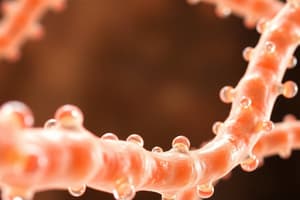Podcast
Questions and Answers
Which enzyme is responsible for converting heme into biliverdin?
Which enzyme is responsible for converting heme into biliverdin?
- Heme oxygenase (correct)
- Biliverdin reductase
- Protoporphyrin
- Transferrin
What substance is formed when biliverdin is reduced?
What substance is formed when biliverdin is reduced?
- Iron
- NADPH
- Bilirubin (correct)
- Heme
What percentage of bilirubin production in normal individuals is derived from the turnover of senescent red blood cells?
What percentage of bilirubin production in normal individuals is derived from the turnover of senescent red blood cells?
- 15%
- 25%
- 100%
- 85% (correct)
What is the primary type of hemoglobin released during the breakdown of senescent red blood cells?
What is the primary type of hemoglobin released during the breakdown of senescent red blood cells?
During red blood cell senescence, what happens to hemoglobin?
During red blood cell senescence, what happens to hemoglobin?
What process primarily occurs in the spleen to destroy senescent red blood cells?
What process primarily occurs in the spleen to destroy senescent red blood cells?
In what organ does phagocytosis of senescent red blood cells predominantly occur?
In what organ does phagocytosis of senescent red blood cells predominantly occur?
Which component of heme is produced when heme is oxidized by microsomal heme oxygenase?
Which component of heme is produced when heme is oxidized by microsomal heme oxygenase?
Which form of bilirubin is typically bound to albumin for transport in the bloodstream?
Which form of bilirubin is typically bound to albumin for transport in the bloodstream?
What is the main effect of hemolysis on bilirubin levels in the body?
What is the main effect of hemolysis on bilirubin levels in the body?
How much bilirubin is produced daily in normal individuals?
How much bilirubin is produced daily in normal individuals?
What role does transferrin play in iron recycling?
What role does transferrin play in iron recycling?
What happens to senescent red blood cells besides being destroyed in the spleen?
What happens to senescent red blood cells besides being destroyed in the spleen?
Which of the following is a contributor to bilirubin production besides the turnover of red blood cells?
Which of the following is a contributor to bilirubin production besides the turnover of red blood cells?
Which of the following statements about heme catabolism is true?
Which of the following statements about heme catabolism is true?
What forms from the split of methemoglobin during the breakdown of senescent red blood cells?
What forms from the split of methemoglobin during the breakdown of senescent red blood cells?
What is the primary role of albumin in the transport of unconjugated bilirubin?
What is the primary role of albumin in the transport of unconjugated bilirubin?
Which protein is responsible for the transport of unconjugated bilirubin within hepatocytes?
Which protein is responsible for the transport of unconjugated bilirubin within hepatocytes?
How is heme reduced to bilirubin during catabolism?
How is heme reduced to bilirubin during catabolism?
What occurs to the iron component released during heme catabolism?
What occurs to the iron component released during heme catabolism?
In which organ does the complex between unconjugated bilirubin and Z proteins form?
In which organ does the complex between unconjugated bilirubin and Z proteins form?
What is the result of the degradation of globin during heme catabolism?
What is the result of the degradation of globin during heme catabolism?
What mechanism is involved in the entry of unconjugated bilirubin into hepatocytes?
What mechanism is involved in the entry of unconjugated bilirubin into hepatocytes?
What happens to unconjugated bilirubin after it is released from albumin within the liver?
What happens to unconjugated bilirubin after it is released from albumin within the liver?
Flashcards are hidden until you start studying
Study Notes
Bilirubin Formation and Metabolism
- The breakdown of heme produces bilirubin, with 1 mole of bilirubin generated for each mole of heme catabolized.
- Iron from heme is bound to transferrin and stored in the liver or bone marrow for future use.
- Globin, the protein part of hemoglobin, is degraded into amino acids for recycling within the body.
Role of Biliverdin and its Reduction
- Biliverdin is formed first from heme through oxidation by heme oxygenase.
- Biliverdin is then converted to bilirubin by biliverdin reductase in the presence of NADPH.
Transport and Conjugation of Bilirubin
- Unconjugated bilirubin is transported in circulation, primarily bound to albumin, which facilitates movement to the liver.
- Unconjugated bilirubin enters hepatocytes via receptor-mediated endocytosis when bound to a specific transport protein.
- Inside hepatocytes, unconjugated bilirubin is released from albumin and forms a complex with Z proteins.
Storage and Processing in the Liver
- Bilirubin binds to a soluble carrier protein, ligandin (Y protein), which transports it to the smooth endoplasmic reticulum (SER).
- In the liver, bilirubin undergoes further processing and conjugation for excretion.
Daily Production and Sources of Bilirubin
- Normal bilirubin production rates are around 250-350 mg daily.
- Approximately 85% of bilirubin is derived from the breakdown of aged red blood cells, while 15% comes from destroyed RBC precursors and heme-containing proteins like myoglobin and cytochromes.
Destruction of Senescent Red Blood Cells
- Senescent red blood cells are primarily destroyed in the spleen by macrophages through phagocytosis, releasing methemoglobin.
- Methemoglobin does not transport oxygen; it is composed of oxidized heme.
- Methemoglobin splits into globin and heme, with heme subsequently oxidized by heme oxygenase to produce biliverdin and release iron.
Studying That Suits You
Use AI to generate personalized quizzes and flashcards to suit your learning preferences.




